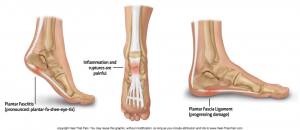Are you experiencing pain and tenderness predominately on the inner portion of your heel on the sole of your foot? Do you have trouble taking your first steps in the morning or after prolonged sitting? This may be caused by plantar fasciitis, which is common among athletes and the sedentary population. The plantar fascia is a ligament that connects your heel bone to your toes and acts as a shock-absorbing bowstring supporting the arch of your foot. When this ligament is strained, the area becomes very weak, swollen and inflamed creating pain at the bottom of your foot when standing or walking.
Straining this ligament is not difficult to do and can be caused by the following situations:
1. Walking with your feet rolling inward, also known as “excessive pronation”
2. High arches in your foot or being flat footed
3. Walking, standing or running for long periods of time on hard surfaces
4. Being overweight
5. Wearing shoes that don’t fit or that are worn out
6. Tightness or inflexibility of the Achilles tendon and/or calf muscles
 In most cases, the diagnosis of this condition is primarily based on a detailed history and physical evaluation. Diagnostic imaging is rarely used to determine the initial diagnosis; however, if this condition becomes a repetitive occurrence, imaging is necessary and beneficial to rule out any other heel pathology.
In most cases, the diagnosis of this condition is primarily based on a detailed history and physical evaluation. Diagnostic imaging is rarely used to determine the initial diagnosis; however, if this condition becomes a repetitive occurrence, imaging is necessary and beneficial to rule out any other heel pathology.
At BTF, the doctors will be able to accurately diagnosis plantar fasciitis and design a detailed treatment protocol to decrease pain and swelling. This will consists of rest, reduced activities, soft tissue therapy, chiropractic adjustments of the ankle joint and foot, stretching techniques, ice massage and oral analgesics. The use of night splints, orthotics for arch support and heel cups/pads may also be helpful.
In conjunction with this treatment, exercises to strengthen the calf muscles and arch of the foot are also recommended. The step rocker exercise is a great tool (see video above). This exercise is done one leg at a time by planting your heel into the ground and rocking forward to the front of your foot and up onto your toes. This movement is done slowly and deliberately to isolate the calf muscles and the intrinsic muscles of your foot as well as targeting your balance.
The treatment approach for plantar fasciitis will get rid of your heel pain; however, it does take time for the pain to completely go away. Be patient and stick with your treatment plan to avoid further issues and constant pain when walking and standing. If you have a heel or foot complaint, please contact our office at 310-534-1900 to schedule an evaluation with one of our doctors at BTF.


